Cracked and leaning buildings remain uninhabited and displaced people live in outdoor camps a year after a magnitude 7.1 earthquake killed 228 people in Mexico's capital and 141 more in nearby states.
The demolition of hundreds of tottering structures has been delayed by physical and legal hurdles, while some owners have carried out cosmetic repairs leaving the buildings vulnerable to the next earthquake to hit Mexico City and surrounding areas.
The slow pace of demolition and rebuilding is frustrating to those who lost their homes and those left living amid shattered eyesores that look like they could collapse at any time onto sidewalks and streets still cordoned off after the Sept. 19, 2017, quake.

This photo combination shows the site at Amsterdam 25 where a building collapsed in last year's 7.1 magnitude earthquake, immediately after the quake on Sept. 19, 2017, top, and one year later, on Sept. 18, 2018, in Mexico City. The slow pace of demolition, let alone rebuilding, is frustrating both to those who lost their homes and to those left living amid shattered eyesores that look like they could collapse at any time onto sidewalks and streets still cordoned off after the 2017 quake. (AP PhotosMarco Ugarte, Rebecca Blackwell)
Of about 411 buildings marked for demolition, only 62 have been taken down, and almost 1,000 more that were seriously damaged have yet to be reinforced.
The destruction and slow pace of recovery from the quake has placed in doubt Mexico City's reliance on self-policing - developers hire the regulatory experts who certify the safety of the buildings they put up - and its ability to punish those responsible.
Nobody has been successfully prosecuted for building collapses, even though experts found evidence of deficient construction in several cases where builders submitted false paperwork, used cheap materials or simply built atop older, unstable structures. Nor has a single apartment building been reconstructed.
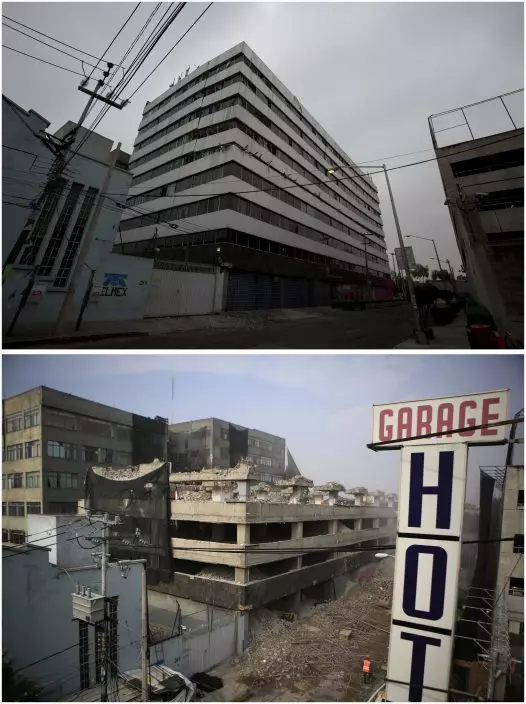
This photo combination shows the site at San Antonio Abad 122 where the fourth story of an office building collapsed in last year's 7.1 magnitude earthquake, one month after the quake on Oct. 18, 2017, top, and being demolished one year later, on Sept. 17, 2018, in Mexico City. The slow pace of demolition, let alone rebuilding, is frustrating both to those who lost their homes and to those left living amid shattered eyesores that look like they could collapse at any time onto sidewalks and streets still cordoned off after the 2017 quake. (AP PhotosRebecca Blackwell)
What little progress has been made seems to have come from demolition workers who break down the upper floors of buildings too tall to use heavy machinery, and quake victims who have slept outside, demonstrated and blocked streets to pressure the government.
People affected complain that authorities have set up a daunting bureaucratic pyramid of paperwork for victims to get their buildings evaluated, repaired, demolished or replaced. About a half of people in Mexico City don't have proof of ownership or titles to their properties, creating a roadblock in their path to restitution.
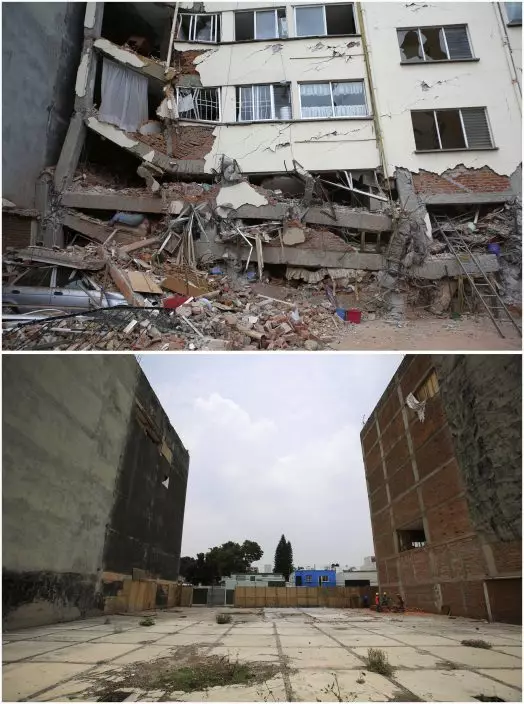
This photo combination shows the site at Coquimbo 911 where the lower floors of an apartment building collapsed in last year's 7.1 magnitude earthquake, during rescue operations on Sept. 20, 2017, top, and one year later, on Sept. 12, 2018, after the building had been demolished and the neighboring buildings were being repaired, in Mexico City. The slow pace of demolition, let alone rebuilding, is frustrating both to those who lost their homes and to those left living amid shattered eyesores that look like they could collapse at any time onto sidewalks and streets still cordoned off after the 2017 quake. (AP PhotosRebecca Blackwell)
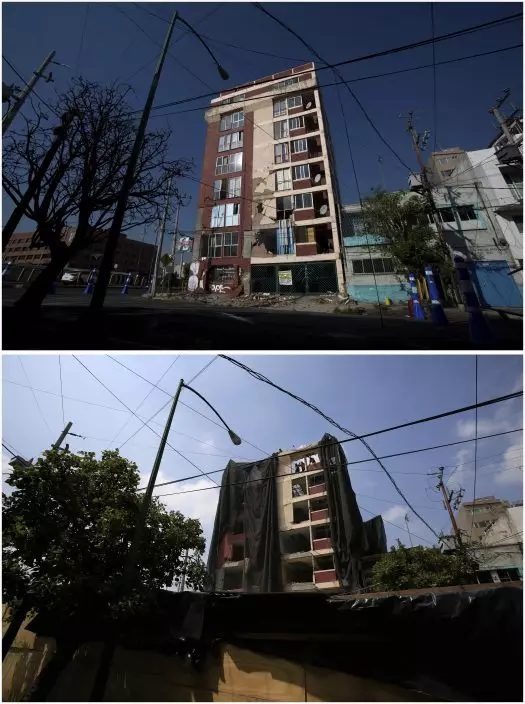
This photo combination shows an apartment building at Tonala and Viaducto Miguel Aleman that was heavily damaged in last year's 7.1 magnitude earthquake, on March 16, 2018, virtually untouched six months after the quake, and on Sept. 18, 2018, shortly after demolition began, in the Roma Sur area of Mexico City. The slow pace of demolition, let alone rebuilding, is frustrating both to those who lost their homes and to those left living amid shattered eyesores that look like they could collapse at any time onto sidewalks and streets still cordoned off after the 2017 quake. (AP PhotosRebecca Blackwell)
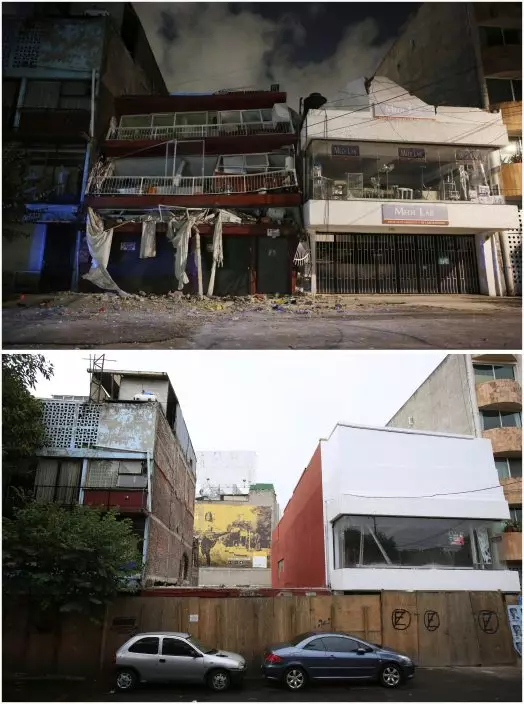
This photo combination shows the site at Coahuila 10 where an apartment building partially collapsed in last year's 7.1 magnitude earthquake, on the day of the quake, Sept. 19, 2017, top, and one year later, on Sept. 16, 2018, after the upper floors of the building had been demolished, in the Roma area of Mexico City. The slow pace of demolition, let alone rebuilding, is frustrating both to those who lost their homes and to those left living amid shattered eyesores that look like they could collapse at any time onto sidewalks and streets still cordoned off after the 2017 quake. (AP PhotosRebecca Blackwell)
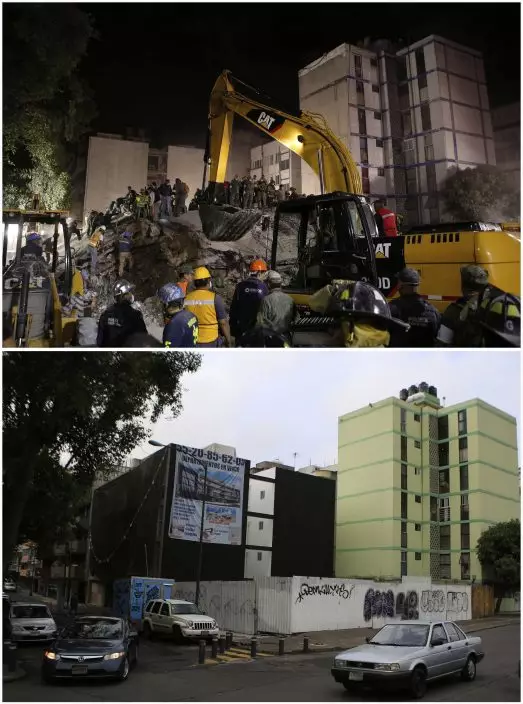
This photo combination shows the site at the corner of Torreon and Viaducto Miguel Aleman where an apartment building collapsed in last year's 7.1 magnitude earthquake, during rescue operations just after midnight on Sept. 20, 2017, top, and one year later on Sept. 17, 2018, long after the rubble had been removed, in Mexico City. The slow pace of demolition, let alone rebuilding, is frustrating both to those who lost their homes and to those left living amid shattered eyesores that look like they could collapse at any time onto sidewalks and streets still cordoned off after the 2017 quake. (AP PhotosRebecca Blackwell)
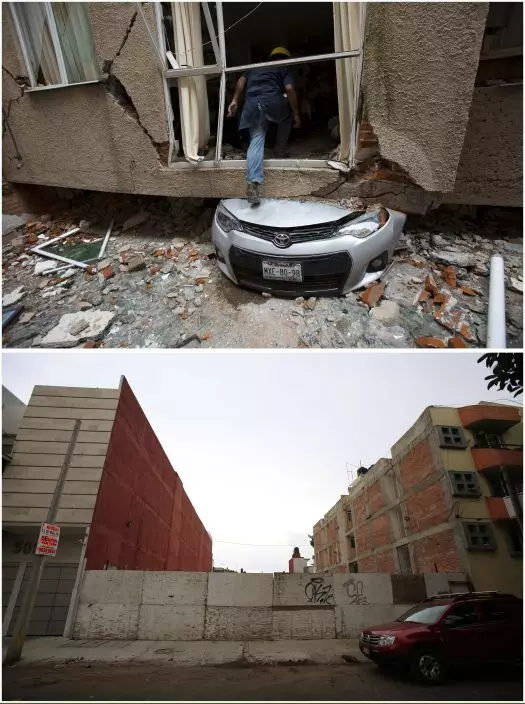
This photo combination shows the site at Tokio 517 where two apartment buildings collapsed and another was heavily damaged in last year's 7.1 magnitude earthquake, one month after the quake on Oct. 18, 2017, top, and one year later, on Sept. 16, 2018, after the buildings had been demolished, in Mexico City. The slow pace of demolition, let alone rebuilding, is frustrating both to those who lost their homes and to those left living amid shattered eyesores that look like they could collapse at any time onto sidewalks and streets still cordoned off after the 2017 quake. (AP PhotosRebecca Blackwell)
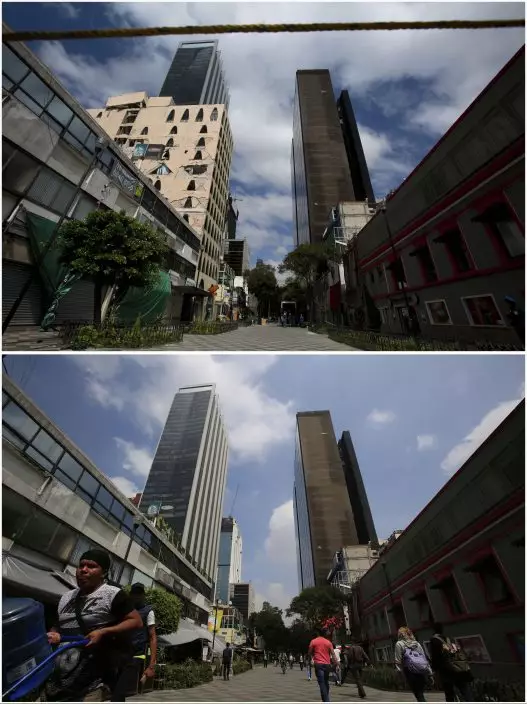
This photo combination shows pedestrian Genova Street, where an office building was badly damaged in last year's 7.1 magnitude earthquake, with the street still closed one month after the quake on Oct. 17, 2017, top, and one year later, on Sept. 17, 2018, after the building had been removed and the street reopened, in the Zona Rosa area of Mexico City. The slow pace of demolition, let alone rebuilding, is frustrating both to those who lost their homes and to those left living amid shattered eyesores that look like they could collapse at any time onto sidewalks and streets still cordoned off after the 2017 quake. (AP PhotosRebecca Blackwell)
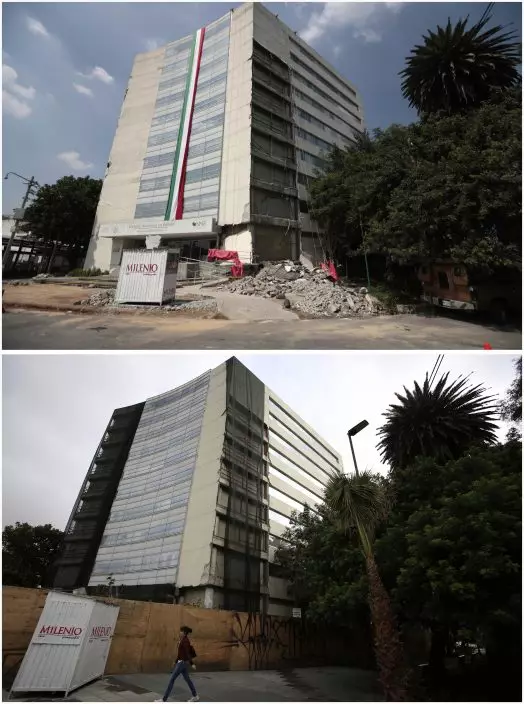
This photo combination shows a government building at Cuauhtemoc 614 that was damaged in last year's 7.1 magnitude earthquake, immediately after the quake on Sept. 19, 2017, top, and virtually untouched one year later, on Sept. 18, 2018, in Mexico City. Of about 411 buildings marked for demolition, only 62 have been taken down, and almost 1,000 more that were seriously damaged have yet to be reinforced. (AP PhotosEduardo Verdugo, Rebecca Blackwell)
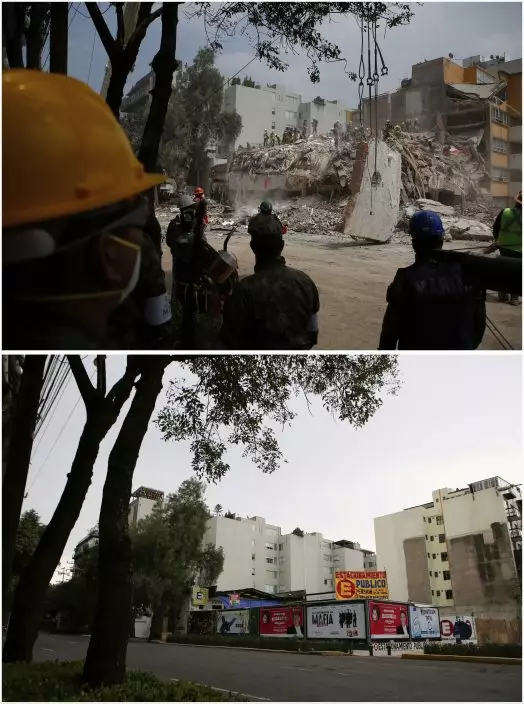
This photo combination shows the site at Escocia 4 where an apartment building collapsed in last year's 7.1 magnitude earthquake, during rescue operations on Sept. 25, 2017, top, and one year later, on Sept. 16, 2018, after the rubble had been removed and an adjacent building demolished in Mexico City. The slow pace of demolition, let alone rebuilding, is frustrating both to those who lost their homes and to those left living amid shattered eyesores that look like they could collapse at any time onto sidewalks and streets still cordoned off after the 2017 quake. (AP PhotosRebecca Blackwell)
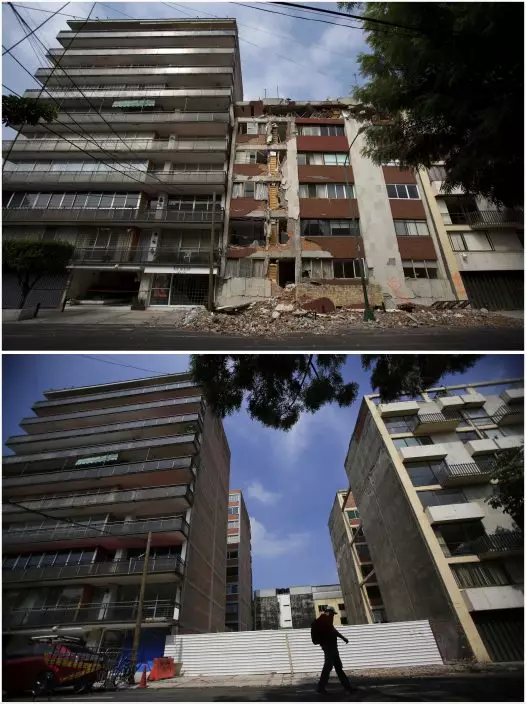
This photo combination shows the site at Patricio Sanz 37, where the lower floor of an apartment building collapsed in last year's 7.1 magnitude earthquake, one month after the quake on Oct. 18, 2017, top, and a year later, on Sept. 17, 2018, after the building had been demolished and the neighboring buildings, damaged in the collapse, were being repaired, in Mexico City. The slow pace of demolition, let alone rebuilding, is frustrating both to those who lost their homes and to those left living amid shattered eyesores that look like they could collapse at any time onto sidewalks and streets still cordoned off after the 2017 quake. (AP PhotosRebecca Blackwell)


